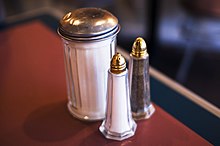Salt and pepper shakers: Difference between revisions
Appearance
Content deleted Content added
| Line 7: | Line 7: | ||
The placement of salt and pepper shakers has been thought to influence healthy diets.<ref>Fewell, A.U. (1916) "Diet Kitchen Methods of Instruction," ''American Journal of Nursing. 17''(2). p. 108.</ref><ref>Clark, D.E. (1953) "The Little Things Do Count," ''American Journal of Nursing. 53''(7 ). p. 814.</ref> |
The placement of salt and pepper shakers has been thought to influence healthy diets.<ref>Fewell, A.U. (1916) "Diet Kitchen Methods of Instruction," ''American Journal of Nursing. 17''(2). p. 108.</ref><ref>Clark, D.E. (1953) "The Little Things Do Count," ''American Journal of Nursing. 53''(7 ). p. 814.</ref> |
||
DANG LETS BANG :) |
|||
==References== |
==References== |
||
Revision as of 18:08, 2 May 2008

Salt and pepper shakers are condiment holders used in Western culture that are designed to allow food eaters to distribute edible salt and ground pepper.[1] This is a conjoined term for salt shaker and pepper shaker.
Usage
Salt and pepper shakers can be made from a variety of substances, including plastics, glass, and ceramic.[2] Aside from table usage, salt and pepper shakers have been used to transmit cultural perspectives about race,[3][4] friendships,[5] and other cultural values.[6]
The placement of salt and pepper shakers has been thought to influence healthy diets.[7][8]
References
- ^ Nelson, W. (2007) "Spepper – Salt and Pepper Seasoning", The Cook's Kitchen. Retrieved 8/21/07.
- ^ Longenecker, E.Z. (1970) "Using the Slush Casting Method to Make Salt and Pepper Shakers." School Shop. 29(6) p. 56.
- ^ Holt, T. (1995) "Marking: Race, Race-making, and the Writing of History," American Historical Review. 100(1) p. 8.
- ^ Dubin, S. (1987) "Symbolic Slavery: Black Representations in Popular Culture," Social Problems. 34(2) p 126.
- ^ Henkes, K. (1998) "Chester's Way", Scholastic. p. 1.
- ^ Hoffman, D.G. (1950) "Folk Tales of Paul Bunyan: Themes, Structure, Style, Sources," Western Folklore. 9(4) p. 316.
- ^ Fewell, A.U. (1916) "Diet Kitchen Methods of Instruction," American Journal of Nursing. 17(2). p. 108.
- ^ Clark, D.E. (1953) "The Little Things Do Count," American Journal of Nursing. 53(7 ). p. 814.
